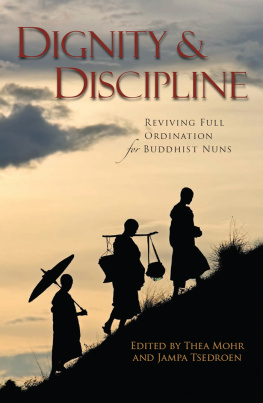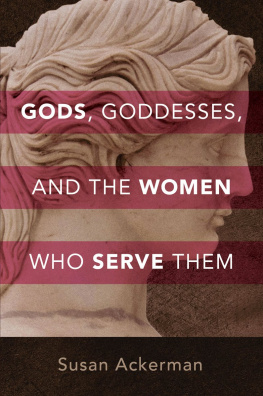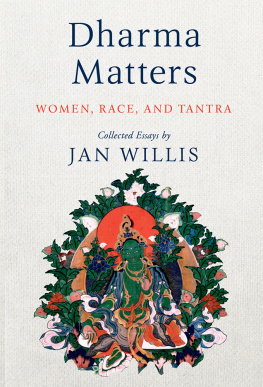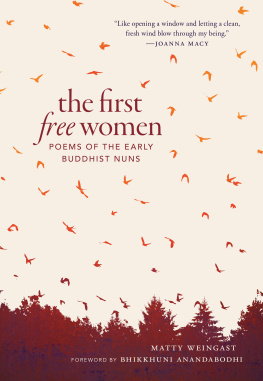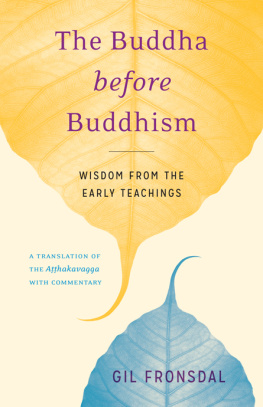FIRST BUDDHIST WOMEN
Dedicated to my mother and father,
who encouraged and supported me
in exploring the wide world freely.
Parallax Press
P.O. Box 7355
Berkeley, CA 94707
www.parallax.org
Parallax Press is the publishing division of Unified Buddhist Church, Inc.
Copyright 1991, 2006 by Susan Murcott.
Distributed by Publishers Group West.
Cover and text design by Gopa & Ted2, Inc.
Map on page 7 by Gay Reineck.
Library of Congress Cataloging In-Publication Data
Murcott, Susan.
First Buddhist women : poems and stories of awakening / Susan Murcott. Rev. ed.
p. cm.
Includes bibliographical references and index.
ISBN 978-1-9352-0911-9
1. Tipiaka. Suttapiaka. Khuddakanikya. ThergthCriticism, interpretation, etc.
2. Women in the Tripitaka. 3. Gautama BuddhaDisciples. 4. Buddhist nunsIndia. I. Tipiaka. Suttapiaka. Khuddakaniky. Thergth. English. Selections. II. Title.
BQ1457.M87 2005
294.38232dc22
2005036330
3 4 5 / 14 13 12
First Buddhist Women
Poems & Songs of Awakening
Susan Murcott

PARALLAX
PRESS
Berkeley, California


Contents

A S A PRACTICING BUDDHIST and a practicing feminist, Ive always had a hard time reconciling my love of the Buddhas teachings with what I saw as historical Buddhisms dismissive attitude toward women. First, I had to contend with the Buddha abandoning his wife and son Rahula (the Pali word for fetter) in order to reach enlightenment. Then, I was uncomfortable with the nearly one third more rules for ordained women than men and the stipulation that even the most venerable nuns had to bow down to a ten year old male novice.
Also, many of the texts were filled with stories about monks succumbing to temptresses. The first monastery I practiced at in Thailand displayed a life- sized painting of a sexy woman. Fish hooks dangled all over her body, most tellingly located at her nipples and genitals. What are you getting into? Id ask myself. It would have been so much easier if I could have been into a nice Goddess religion instead.
But I was a Buddhist, that was clear. I was too devoted to my meditation practice and too enamored with what I was discovering on the path to stop now. Luckily, I had some cool contemporary female meditation teachers as role models. As for the status of women in historical Buddhism, I figured Id just have to not focus on it.
Then one day, somewhere, somebody passed me a copy of Susan Murcotts First Buddhist Women. I felt like I had died and gone to heaven.
At last, an intelligent feminist scholar was tackling the subject of early Buddhist women with sincerity and insight. Murcott has taken songs of the nuns from the time of the historical Buddha (called the Therigatha) and explored their political, social, and cultural climate. She explains history. She asks the right questions. Her astute analysis has helped me understand what made the nuns order what it was. Her translations are simultaneously down- to- earth and mystical.
But best of all, she has brought these nuns to life. She tells the stories of their lives in detail and shares their poems and songs of awakening.
Through Murcott, you will meet Bhadda Kundalakesa, the brilliant debater who was the swiftest of all the nuns to reach enlightenment. She was ordained by the Buddha, in a rare gesture of respect, with two words, Come, Bhadda.
You will meet Kisagotami, who after vainly searching for a white mustard seed from a house where no one has died, found what does not die.
And you will meet Uttama, who sang,
I have found what is vast and empty, the unborn.
It is what Ive longed for.
I am a true daughter of the Buddha,
always finding joy in peace.
First Buddhist Women has been my secret retreat book for a number of years. Ive squirreled it away into silent retreats and when inspiration flagged, Ive whipped out my dog- eared copy and read a former courtesans song of enlightenment.
This book gave me hope. And it had an unintended consequence. After Id read it the first few times, I started to want to be like the women I read about. Every time I read of Khema giving up her gowns and wealth, I would imagine that it could be me. I began to think about cutting off my long red hair. What would it be like to practice just like they did? What would happen to my meditation practice if I ordained as a nun? Could I have a purity of heart just like these women?
About five years after first reading this book, I flew to a Burmese mon astery and took robes as a Buddhist nun. I would practice intensive vipassana meditation. I brought the book with me for secret sustenance.
Meditating as a nun really was different. I felt tied to the long line of women who had ordained and lived this life before me. It was as though I carried their protection; that they were rooting for me. I could sense them. Maybe it was in my head, but I had brought them to life so vividly that they became my companions.
I did not, as it turns out, stay a nun forever and so lost my chance to have my own mystical song recorded for history. But my year as a nun was the most extraordinary year of my life, in all its difficulties and complications. This book led me there. And it transformed me.
With this new edition, you too will have the chance to meet these remarkable women. Whether this book changes your life direction, as it did mine, or just gives you inspiration for the direction you are already heading, it is a treasure worth keeping.
Diana Winston

T HE THERIGATHA is a collection of seventy- three poems in the canon of the earliest Buddhist literature. Theri means women elders, or women who have grown old in knowledge, and gatha means verse, stanza, or song. Hence the Therigatha are the poems of the wise women of early Buddhism. In force and beauty, these religious poems rank with the best of Indian lyric poetry, from the hymns of the


